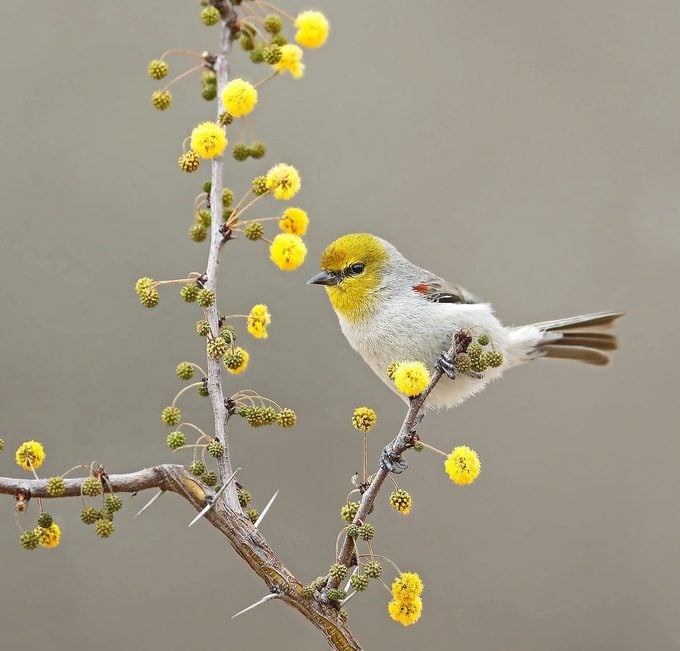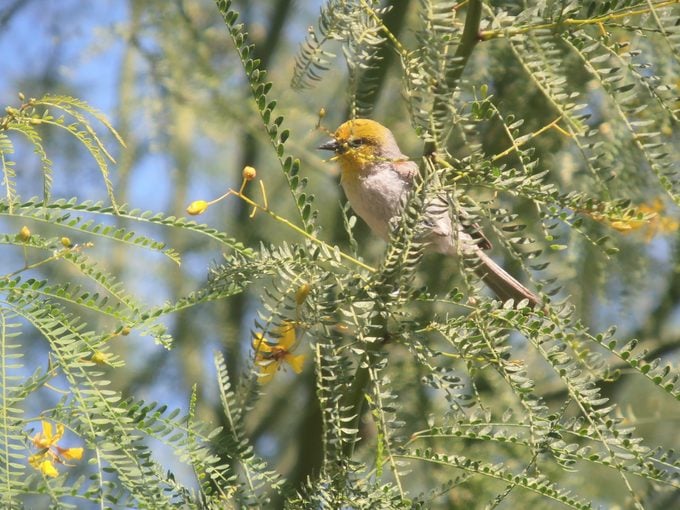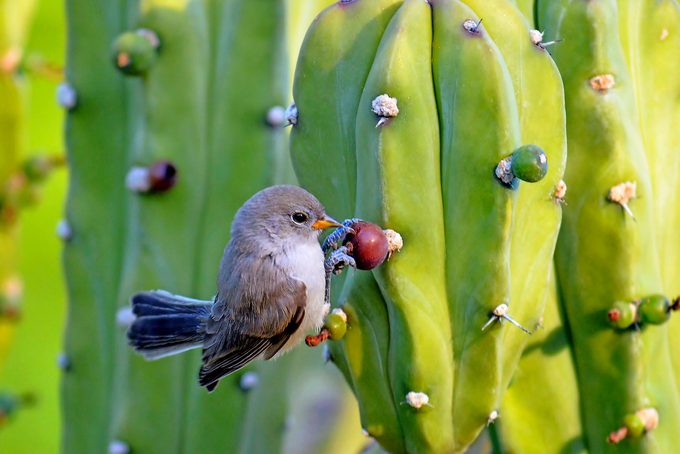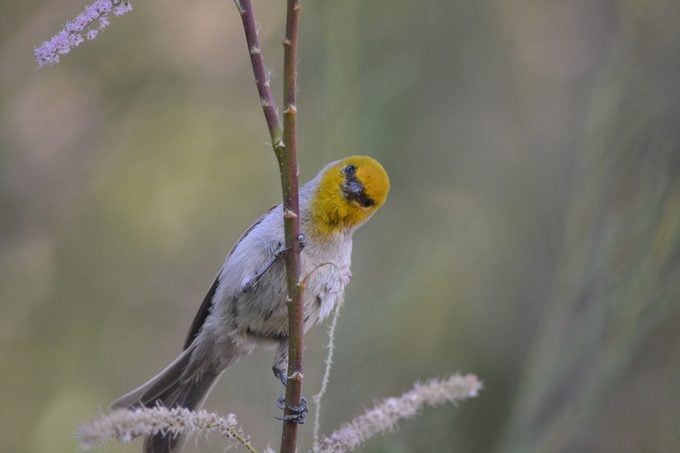Look for a Verdin Bird in the Southwest
Updated: Jul. 09, 2024
Find and attract a verdin in southwestern scrublands. Plus, learn about verdin nests, see what verdins look like, and what foods they eat.
On This Page
What Does a Verdin Look Like?

A verdin is a tiny gray bird of brush habitats, from southern Utah and southwestern Oklahoma to central Mexico. Despite being relatively common and active, like a warbler, this energetic species can be easy to miss.
“Their coloration is so generally cryptic that it feels like a treat to spot one hopping about in the branches—and to get to see the yellow color on its head or the rust color on its shoulder,” says Jennie Duberstein, coordinator for the Sonoran Joint Venture.
According to birding experts Kenn and Kimberly Kaufman, verdins used to be classified in the same family as chickadees, but new research shows that their closest relatives are certain small songbirds in Europe, Asia and Africa.
Visit Saguaro National Park near Tucson, Arizona, to get a good look at verdin.
Check out more small yellow birds you should know.
Diet: What Does a Verdin Eat?

Verdins dine mostly on insects. To attract the birds, Jennie has a few recommendations. “Focus on providing verdins the plants and trees with the structures and food sources they need,” she says. “In my yard they love the mesquite and paloverde trees, and they are also fans of cactus like chollas.”
These spunky fliers often visit hummingbird feeders for sugar water and nectar plants. So a garden with native flowering plants may draw them in. Agile verdins can even eat while hanging upside down.
Discover more desert birds of the Southwest.
Verdin Nests
Verdins construct incredible round abodes all year long, using some for nesting and others for roosting. Their homes are typically about 6 inches wide with an opening situated toward the bottom.
“These thorny globes are all-purpose houses, providing great protection from predators and extreme temperatures,” Jennie says. Verdins’ domed homes stay cooler in the summer and warmer in winter.
Male verdins stay involved and play a critical role in nest construction. The bird dads mostly set up the thorny outer structures. Females handle the interior decorating, adding a soft lining that’s usually a combo of grass and plant fibers.
Backyard Tip: In the Southwest, plant native shrubs to attract verdins for nesting and roosting, and to provide shade for them during hot summers.
Look for the gila woodpecker in the desert.
What Does a Juvenile Verdin Look Like?

A juvenile verdin sports an all-gray look and a bright yellow beak that dulls over time.
“I spotted this young verdin (above) on an early morning walk,” says Birds & Blooms reader Caroline Horowitz of Chandler, Arizona.
Meet the Costa’s hummingbird: jewel of the desert.
Verdin Song
Bird sounds courtesy of the Cornell Lab of Ornithology
The male verdin’s song is a simple tseet tsor tsor whistle. Males and females both give a loud chip call, sometimes in a rapid progression.
Until she learned to recognize their three-note whistle, Jennie didn’t realize how ubiquitous verdins were in her region. “Once I had it imprinted on my brain, I realized they were everywhere even if I couldn’t immediately see them,” she says.
Whenever she hears verdins now, Jennie looks to the trees and tries to spot them. Males do much of the singing, but during the breeding season females will occasionally sing back.
Learn to identify a pyrrhuloxia, the desert cardinal of the Southwest.
How to Support Verdins

While verdins are still common, their population declined 60% in North America between 1968 and 2015. This rate of decline is alarming for Jennie, who didn’t grow up in the Southwest and says it’s a daily thrill to see verdins now.
The species is particularly vulnerable to habitat loss. This bird likes open habitats, and it will readily come into yards that have a few native trees and shrubs such as mesquites, acacias or palo verdes. One threat is buffelgrass (Pennisetum ciliare), an invasive plant that is altering fire patterns throughout much of the bird’s range.
By supplying plants that verdins rely on—and by protecting Sonoran habitats—we can all help ensure that this spirited desert specialist continues to thrive.
Next, learn why you should head southwest to see a cactus wren.
About the Expert
Wildlife biologist and conservation social scientist Jennie Duberstein is the coordinator for the Sonoran Joint Venture. Jennie received a Ph.D. from the University of Arizona’s School of Natural Resources and the Environment.






















